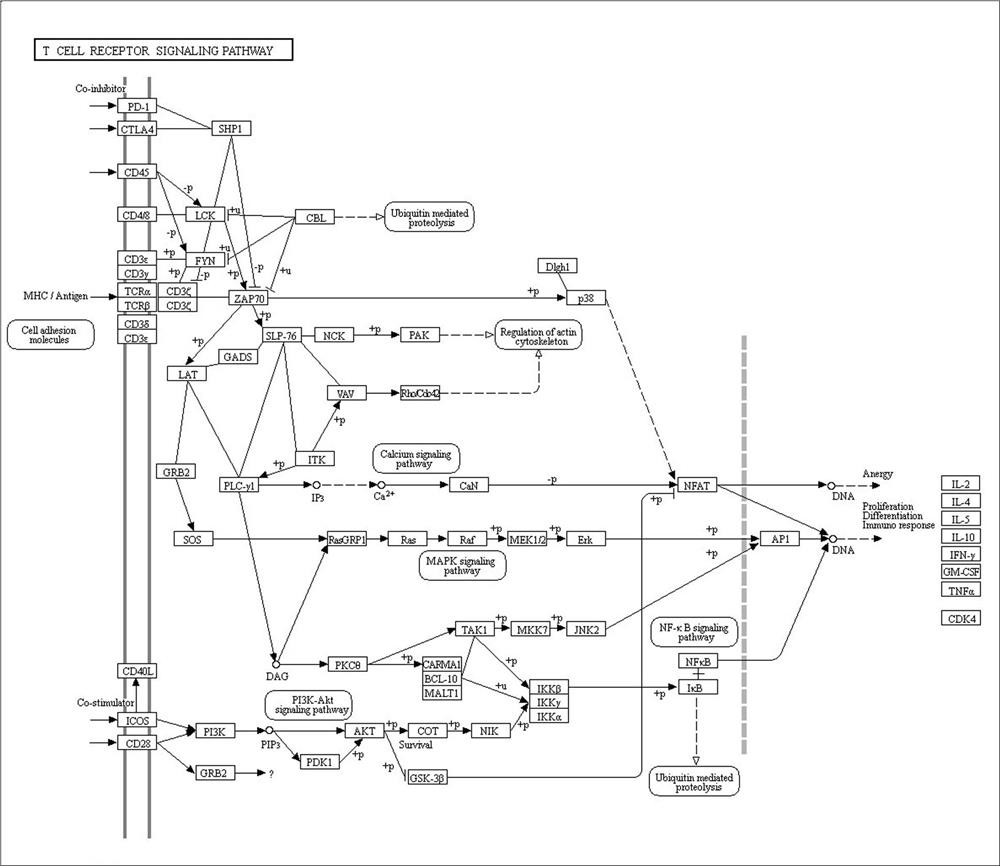DNA probe pool for detecting genes and SNP sites related to Kawasaki disease, its preparation method and use
A DNA probe, a technology for Kawasaki disease, applied in the field of molecular biology, can solve the problems of inability to accurately type patients and provide reliable test results with medication, no similar detection products for Kawasaki disease, and difficult analysis.
- Summary
- Abstract
- Description
- Claims
- Application Information
AI Technical Summary
Problems solved by technology
Method used
Image
Examples
preparation example Construction
[0055] Another aspect of the embodiments of the present invention also provides the aforementioned method for preparing a DNA probe pool for detecting genes related to Kawasaki disease and SNP sites, which includes:
[0056] Select the exon regions of genes involved in T cell receptor signaling pathway, Toll-like receptor signaling pathway, cytokine receptor signaling pathway, and TGF-β signaling pathway, and screen a total of 560 genes related to Kawasaki disease, including 466 SNP positions point;
[0057] Obtain different transcripts of each gene, map them to the HG19 human standard reference genome through position information, and select sequences that can cover all transcripts;
[0058] Make the exon part extend 15bp to the intron at the 3' and 5' ends,
[0059] Each of the oligonucleotide probe sequences has at least 50% sequence overlap, the probe sequence with a CG content of 40-60% in the target region covers 2 times, and the CG content in the target region is less ...
Embodiment example
[0094] Wherein, as a more specific implementation case of the present invention, a method for qualitative detection of Kawasaki disease gene in vitro comprises the following steps:
[0095] (1) DNA probe preparation
[0096] (1.1) DNA probe design: Kawasaki disease-related immune signaling pathways were obtained from KEGG, and a total of 560 genes including 466 SNP sites were screened through the literature.
[0097] The principles of oligonucleotide design are:
[0098] 1) Different transcripts of each gene are mapped to the HG19 human standard reference genome through position information, and sequences that can cover all transcripts are selected.
[0099] figure 1 For the exon collection method of the 6 transcripts of the PTPN22 gene, different transcripts are mapped to the hg19 reference genome, and a schematic diagram containing the sequences of all transcripts is generated; the sequence interval used to design probes includes the exons of all transcripts Exon region. ...
Embodiment 1
[0141] Screening of markers for predicting the risk of coronary artery injury induced by Kawasaki disease
[0142] Screening methods and steps such as Figure 7 Shown:
[0143] 1. Approved by the Ethics Committee, take 1mL of whole blood from 50 children with Kawasaki disease complicated with CAL and 1mL of whole blood from 50 children with Kawasaki disease without CAL, use EDTA anticoagulant tubes uniformly for blood collection, and store at 4°C for no more than 48 hours , long-term storage in liquid nitrogen.
[0144] 2. Take 200uL of whole blood and use the QiaAmp Blood Mini Kit for DNA extraction. The extraction operation is carried out in full accordance with the operation manual of the kit.
[0145] 3. Take 1ug of the extracted DNA, and use the KAPA LTP DNA Library Preparation Kit to construct the next-generation sequencing library. The library construction operation is completely carried out according to the operation manual of the kit.
[0146] 4. Group the construc...
PUM
 Login to View More
Login to View More Abstract
Description
Claims
Application Information
 Login to View More
Login to View More - R&D
- Intellectual Property
- Life Sciences
- Materials
- Tech Scout
- Unparalleled Data Quality
- Higher Quality Content
- 60% Fewer Hallucinations
Browse by: Latest US Patents, China's latest patents, Technical Efficacy Thesaurus, Application Domain, Technology Topic, Popular Technical Reports.
© 2025 PatSnap. All rights reserved.Legal|Privacy policy|Modern Slavery Act Transparency Statement|Sitemap|About US| Contact US: help@patsnap.com



